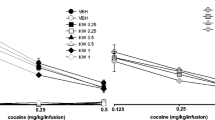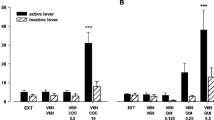Abstract
Rationale
Previous studies have shown that adenosine A2A receptors are colocalized with dopamine D2 receptors on striatal neurons. Activation of these two receptors has antagonistic effects under a number of conditions suggesting that stimulation of adenosine A2A receptors may have behavioral effects resembling those produced by blockade of dopamine D2 receptors, but this possibility has been investigated in a limited number of situations.
Objective
We compared the effects of the adenosine A2A agonist CGS-21680 and the preferential D2 dopamine antagonist haloperidol in a situation in which dopamine blockade produces a distinctive pattern of behavioral effects.
Materials and methods
Six rats were trained to lever press for food reward on a fixed ratio 15 schedule of reinforcement and then tested after being injected with various doses of CGS-21680 (0.064, 0.128, and 0.25 mg/kg) and haloperidol (0.25 and 0.1 mg/kg).
Results
Haloperidol produced a dose-dependent suppression of lever pressing with mean response rates declining across the duration of the test session. CGS-21680 also produced a dose-dependent suppression of responding, but this effect was not temporally graded, and responding was equivalently suppressed across the duration of the session. Additionally, CGS-21680 increased post-reinforcement pause duration to a much greater extent than did haloperidol.
Conclusions
On this task, the behavioral effects of CGS-21680 do not resemble those produced by haloperidol. Several explanations of this discrepancy are possible, the most likely being that the observed behavioral effects of CGS-21680 result from an action at a site other than D2 receptor-expressing striatal neurons.




Similar content being viewed by others
References
Augood SJ, Emson PC (1994) Adenosine A2a receptor mRNA is expressed by enkephalin cells but not by somatostatin cells in rat striatum: a co-expression study. Mol Brain Res 22:204–210
Beninger RJ, Ranaldi R (1993) Microinjections of flupenthixol into the caudate-putamen but not the nucleus accumbens, amygdala or frontal cortex of rats produce intra-session declines in food-rewarded operant responding. Behav Brain Res 55:203–212
Boegman RJ, Vincent SR (1996) Involvement of adenosine and glutamate receptors in the induction of c-fos in the striatum by haloperidol. Synapse 22:70–77
Cunha RA, Johansson B, van der Ploeg I, Sebastiao AM, Ribeiro JA, Fredhlom BB (1994) Evidence for functionally important adenosine A2a receptors in the rat hippocampus. Brain Res 649:298–216
Dews PB (1956) Modification by drugs of performance on simple schedules of positive reinforcement. Ann N Y Acad Sci 65:268–281
Ferre S, O'Connor WTO, Fuxe K, Ungerstedt U (1993) The striopallidal neuron: a main locus for adenosine-dopamine interactions in the brain. J Neurosci 13:5402–5406
Fink JS, Weaver DR, Rivkees SA, Peterfreund R, Pollack AE, Adler EM, Reppert SM (1992) Molecular cloning of the rat A2 adenosine receptor: selective co-expression with D2 dopamine receptors in rat striatum. Mol Brain Res 14:186–195
Font L, Mingote S, Farrar AM, Percira M, Worden L, Stopper C, Port RG, Salamone JD (2008) Intra-accumbens injections of the adenosine A2A agonist CGS 21680 affect effort-related choice behavior in rats. Psychopharmacol 199:515–526
Fowler SC (1990) Neuroleptics produce within-session response decrements: facts and theories. Drug Dev Res 20:101–116
Fuxe K, Ferre S, Canals M, Torvinen M, Terasmaa A, Marcellino D, Goldberg SR, Staines W, Jacobsen KX, Woods AS, Agnati LF, Franco R (2005) Adenosine A2A and dopamine D2 heteromeric receptor complexes and their function. J Mol Neurosci 26:209–220
Fuxe K, Ferre S, Genedani S, Franco R, Agnati LF (2007) Adenosine receptor-dopamine receptor interactions in the basal ganglia and their releveance for brain function. Physiol Behav 92:210–217
Grove R, Thompson T (1970) The effects of pentobarbital on performance mantained by an interlocking fixed-ratio fixed-interval reinforcement schedule. In: Thompson T, Pickens R, Meisch RA (eds) Readings in behavioral pharmacology. Appleton, New York, pp 583–593
Hammond EO, Torok ML, Ettenberg A (1991) Different patterns of behavior produced by haloperidol, pentobarbital, and dantrolene in tests of unconditioned locomotion and operant responding. Psychopharmacol 104:150–156
Hauber W, Munkle M (1997) Motor depressant effects mediated by dopamine D2 and adenosine A2a receptors in the nucleus accumbens and caudate putamen. Eur J Pharmacol 323:127–131
Kafka SH, Corbett R (1996) Selective adenosine A2a receptor/dopamine D2 receptor interactions in animal models of schizophrenia. Eur J Pharmacol 295:147–154
Karcz-Kubicha M, Ferre S, Diaz-Ruiz O, Quiroz-Milina C, Goldberg SR, Hope BT, Morales M (2006) Stimulation of adenosine receptors selectively activates gene expression in striatal enkephalinergic neurons. Neuropsychopharmacol 31:2173–2179
Mayfield RD, Larson G, Orona RA, Zahniser NR (1996) Opposing actions of adenosine A2a and dopamine D2 receptor activation on GABA release in the basal ganglia: evidence for an A2a/D2 receptor interaction in globus pallidus. Synapse 22:132–238
Mingote S, Pereira M, Farrar AM, McLaughlin PJ, Salamone JD (2008) Systemic administration of the adenosine A2A agonist CGS 21680 induced sedation at doses that suppress lever pressing and food intake. Pharmacol Biochem Behav 89:345–351
Morelli M, Fenu S, Pinna A, Di Chiara G (1994) Adenosine A2 receptors interact negatively with dopamine D1 and D2 receptors in unilaterally 6-hydroxydopamine-lesioned rats. Eur J Pharmacol 251:21–25
Morelli M, Pinna A, Wardas J, Di Chiara G (1995) Adenosine A2 receptors stimulate c-fos expression in striatal neurons of 6-hydroxydopamine lesioned rats. Neurosci 67:49–55
Pinna A, Wardas J, Cristalli G, Morelli M (1997) Adenosine A2a receptor agonists increase Fos-like immunoreactivity in mesolimbic areas. Brain Res 759:41–49
Popoli P, Pezzola A, Reggiio R, Caporali MG, De Carolis AS (1994) CGS 21680 antagonizes motor hyperactivity in a rat model of Huntington's disease. Eur J Pharmacol 257:R5–R6
Quiroz C, Lujan R, Uchigashima M, Simoes AP, Lerner TN, Borycz J, Kachroo A, Canas PM, Orru M, Schwarzschild MA, Rosin DL, Kreitzer AC, Cunha RA, Watanabe M, Ferre S (2009) Key modulatory role of presynaptic adenosine A2A receptors in cortical neurotransmission to the striatal direct pathway. Scientific World Journal 9:1321–13344
Rimondini R, Ferre S, Ogren SO, Fuxe K (1997) Adenosine A2a agonists: a potential new type of atypical antipsychotic. Neuropsychopharmacol 27:82–91
Rimondini R, Ferre S, Gimenez-Llort L, Ogren SO, Fuxe K (1998) Differential effects of selective adenosine A1 and A2A receptor agonists on dopamine receptor agonist-induced behavioural responses in rats. Eur J Neurosci 347:153–158
Rosin DL, Robeva A, Woodward RL, Guyenet PG, Linden J (1998) Immunohistochemical localization of adenosine A2a receptors in the rat central nervous system. J Comp Neurol 401:163–186
Sanger DJ (1986) Resonse decrement patterns after neuroleptic and non-neuroleptic drugs. Psychopharmacol 89:98–104
Sanger DJ (1987) The actions of SCH 23390, a D1 receptor antagonist, on operant and avoidance behavior in rats. Pharmacol Biochem Behav 26:509–513
Sanger DJ, Perrault G (1995) Effects of typical and atypical antipsychotic drugs on response decrement patterns in rats. J Pharmacol Exp Ther 272:708–713
Satoh S, Matsumura H, Kolke N, Tokunaga Y, Maeda T, Hayaishi O (1999) Region-dependent difference in the sleep-promoting potency of an adenosine A2A receptor agonist. Eur J Neurosci 11:1587–1597
Schiffmann SN, Jacobs O, Vanderhaeghen JJ (1991) The striatal restricted adenosine A2 receptor (RDC8) is expressed by enkephalin but not substance P neurons: an in-situ hybridization study. J Neurochem 57:1062–1067
Sidman M, Stebbins WC (1954) Satiation effects under fixed-ratio schedules of reinforcement. J Comp Physiol Psychol 47:114–116
Svenningsson P, Lindskog M, Rogoni F, Fredholm BB, Greengard P, Fisone G (1998) Activation of adenosine A2a and dopamine D1 receptors stimulates cyclic AMP-dependent phosphorylation of DARP-32 in distinct populations of striatal projection neurons. Neurosci 84:223–228
Tanimura Y, Vaziri S, Lewis MH (2010) Indirect basal ganglia pathway mediation of repetitive behavior: attenuation by adenosine receptor agonists. Behav Bain Res 210:116–122
Turgeon SM, Pollack AE, Schusheim L, Fink JS (1996) Effects of selective adenosine A1 and A2a agonists on amphetamine-induced locomotion and c-Fos in striatum and nucleus accumbens. Brain Res 707:75–80
Wardas J (2008) Potential role of adenosine A2A receptors in the treatment of schizophrenia. Front Biosci 13:4071–4096
Weiss SM, Whawell E, Upton R, Dourish CT (2003) Potential for antipxychotic and psychotomimetic effects of A2A receptor modulation. Neurol 61(suppl 6):S88–S93
Wirtshafter D, Asin KE (1985) Haloperidol and nonreinforcement produce different patterns of response slowing in a food reinforced runway task. Pharmacol Biochem Behav 22:661–663
Wise RA, Spindler J, de Wit H, Gerberg GJ (1978a) Neuroleptic-induced “anhedonia” in rats: pimozide blocks reward quality of food. Sci 201:262–264
Wise RA, Spindler J, Legault L (1978b) Major attenuation of food reward with performance-sparing doses of pimozide in the rat. Can J Psychol 32:77–85
Acknowledgments
This publication is based upon work supported by grants 0641943 from the National Science Foundation, R01DK071738 from the National Institute of Diabetes and Digestive and Kidney Diseases, and R03DA020802 from the National Institute for Drug Abuse. The content is solely the responsibility of the authors and does not necessarily represent the official views of the National Science Foundation or the National Institutes of Health.
Author information
Authors and Affiliations
Corresponding author
Rights and permissions
About this article
Cite this article
Jones-Cage, C., Stratford, T.R. & Wirtshafter, D. Differential effects of the adenosine A2A agonist CGS-21680 and haloperidol on food-reinforced fixed ratio responding in the rat. Psychopharmacology 220, 205–213 (2012). https://doi.org/10.1007/s00213-011-2467-1
Received:
Accepted:
Published:
Issue Date:
DOI: https://doi.org/10.1007/s00213-011-2467-1




